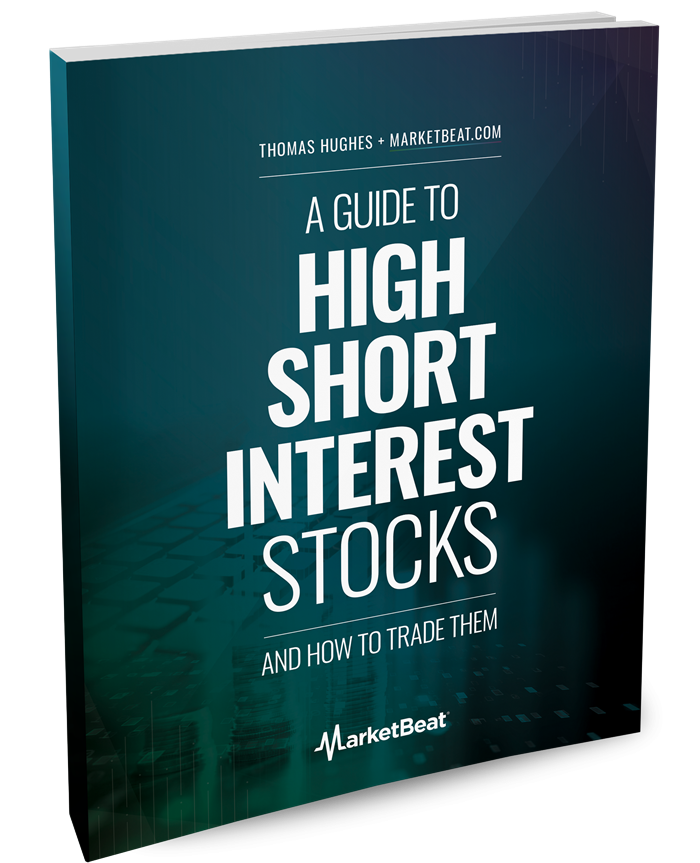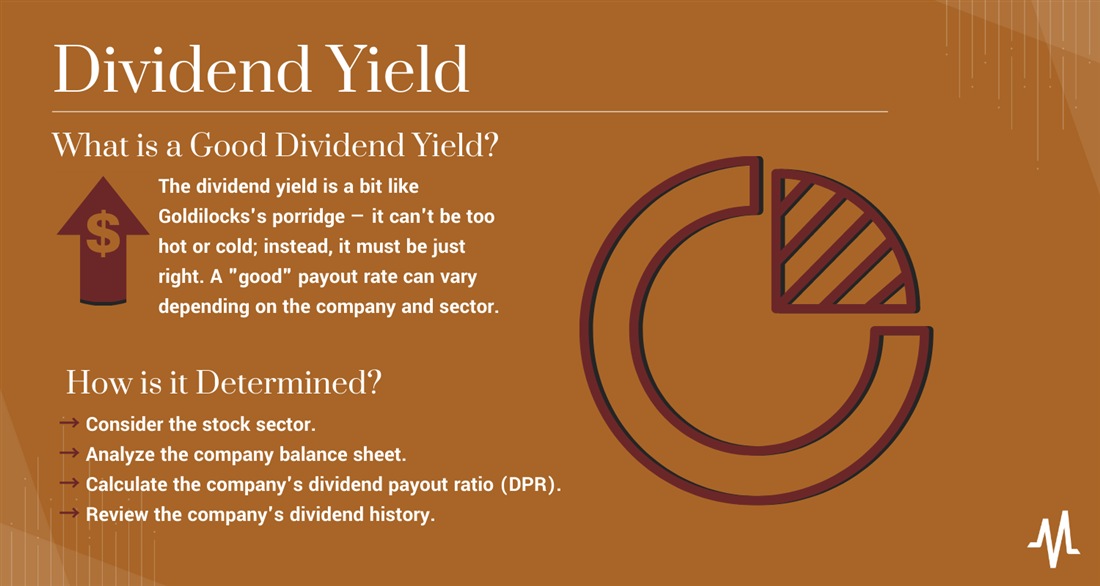Key Points
- Dividend yield measures how much a company pays its shareholders in dividends on a per-share basis.
- Dividend yield varies across different companies and stock sectors.
- To properly evaluate a dividend yield, use metrics like dividend payout rate to gauge future sustainability.
- 5 stocks we like better than Apple
What is a good dividend yield, exactly? When evaluating different stocks to invest in, you’ll notice some pay high dividends, some pay low dividends, and others pay none.
A dividend is a portion of a company’s profits returned to shareholders as income, so naturally, we’d want to search for companies paying the highest dividend yield, right? Well, not exactly.
Evaluating dividends is more complex than buying stocks with the highest yields. Many factors come into play when considering dividends. You’ll need to understand a few different ratios and valuation metrics to determine if a company pays a good dividend yield.
Understanding dividend yield
Calculating dividend yield is a relatively simple equation to solve. The dividend yield is a percentage (not the company’s total dividend payout to reward investors). The yield is a metric used to evaluate cash flow or the rate at which a company returns profits to its stockholders on a per-share basis. The dividend yield may not tell you much about an individual firm, but it’s a helpful measurement for comparing stocks and industries. The calculation for dividend yield looks like this:
Dividend yield = Annual dividend payout amount per share / Price per share.
For example, Procter and Gamble Company NYSE: PG has an impressive dividend history with six decades of payout increases. This year, PG paid shareholders $3.76 in dividends for each share owned, with the fourth quarter dividend announced on October 10. With a share price of $144.62, a $3.76 annual payout yield is 2.6%. The share price rose in the weeks following the payout, which caused the yield rate to fall to 2.48%. Companies focus on payout amounts, while yield is more of a tool for individual investors.
As you can see, the dividend yield fluctuates over time as share prices gyrate, so using dividend yield as your only evaluation metric would be foolhardy. Moreover, the dividend yield isn’t a forward-looking metric and tells us little about a company’s prospects. So what is a good average dividend yield? You’ll need to consider a few other evaluation formulas to answer that.
The impact of economic conditions on dividend yields
How do market conditions affect dividend payouts? The recent bout of inflation is a good example of how the broader economy influences these decisions. As inflation rises, companies with the power to pass on costs are often older, dividend-paying firms. If a company can successfully pass on its costs, the stock could also appreciate as investors look for safe places for their capital.
When stock prices decline, yields increase, which means dividend payers offer more bang for the buck in bear markets. But high yields can also be a sign of trouble, so further analysis of payout rates and increases is required to paint a full picture of a dividend’s security.
What is a good dividend yield?
Determining a good dividend yield requires more than just knowing the number. There’s no answer to questions like, “What is a good annual dividend yield?” or “What is a good average annual dividend yield?” There are simply too many variables.
Is a 2% yield good? What about a 5% yield? A company with a dividend yield of 5% is better for investment than one with a 2% yield, right? You might be surprised, but the answer is “no.”
You can’t simply look at the yield, select the highest-yielding dividend stocks and expect to outperform the market. The dividend yield is a bit like Goldilocks’s porridge — it can’t be too hot or cold; instead, it must be just right.
The dividend payout ratio (DPR) is a critical metric for evaluating the sustainability of a company’s dividend. Instead of dividing the annual dividend payout by the share price as in dividend yield, the DPR looks at the percentage of a company’s profits that goes toward paying dividends. The DPR formula looks like this:
Dividend Payout Rate = Total Dividends / Company Net Income
You can also find the dividend payout rate by taking the dividend payout per share and dividing it by net income per share. The DPR number shows how much (or little) a burden the dividend payout is on the company’s balance sheet.
Once again, a “good” payout rate can vary depending on the company and sector, but it’s easier to discern a stable dividend from a troubled one using the DPR calculation. For example, a payout rate of 30% is good for a company in a more growth-focused industry like tech, where retaining profits for R&D is crucial. On the other hand, an established company with little need for extensive R/D, like a bank or consumer staples producer, can have a payout rate over 50% and still be considered healthy.
If you see a dividend payout rate above 90%, be cautious. A company that devotes 90% or more of its earnings to a dividend could be in a precarious position should financial difficulties arise. Even the most mature and cost-conscious companies cannot sustain paying a dividend that absorbs too much of their net income. If the company can’t sustain its dividend, it’ll cut it. Dividend cuts can be brutal since investors lose out on expected income, faith in the company’s future could suffer, and the stock price could fall.
Identifying high-quality dividend stocks
Payouts aren’t set in stone, and companies can raise, lower or cut the dividend if it’s best for the business. Of course, slashing or cutting a dividend is something companies try to avoid whenever possible since a dividend cut usually precedes a turbulent stock price decline, even in companies with strong histories. When Ford Motor Co. NYSE: F suspended its dividend in 2006, the stock price suffered immediately and failed to rebound to its pre-cut level until after the Great Recession in 2010.
How does an investor find secure dividend stocks? Here’s a checklist of items to look for when building your income-earning portfolio:
- Dividend stock royalty: You’ll often see stocks labeled “Dividend Aristocrat” or “Dividend King.” These companies have a long history of raising their dividend payouts (in the case of the Dividend Kings, it’s 50 years or more). Becoming a Dividend King is very prestigious and signals a company with the power to endure any economic condition.
- Dividend payout rate: How much of the company’s revenue goes toward dividend payments? When a DPR exceeds 90%, dividend investors look for red flags.
- Dividend ratio growth: Companies love to brag about increasing dividend payouts, but what about companies with accelerating dividend growth rates? A firm like 3M Company NYSE: MMM has increased payments for 65 straight years and increased the yield from under 2% to 6.25% since 2013.
Why do you need to know dividend yield?
The dividend yield isn’t a ratio you can use alone to evaluate a specific stock, but it’s still a useful formula for investors. Comparing a rate to the share price provides more information than a dividend payout. A company with a $200 stock price paying $2 per share annually in dividends isn’t rewarding shareholders, as well as a company with a $50 stock price that pays $1.75 in annual dividends.
The dividend yield helps compare dividends across different stocks and sectors. For example, using dividend yield is how we know tech companies retain more earnings for growth than consumer staples or utility companies. Comparing the dividend yield of different sectors can be a good risk assessment tool when building a portfolio. Plus, you can compare the dividend yield of similar companies within the same sector to find the ones returning the most capital to shareholders. To find and compare different yields, use MarketBeat’s dividend yield calculator.
When is a dividend yield too low?
A low dividend yield isn’t necessarily a cause for concern. For example, Apple Inc. NASDAQ: AAPL pays a small yield because it retains most of its earnings for research and development in new projects. Apple’s stock performance over time shows that investors are still getting rewarded even without large dividends.
Instead of simply looking at a company’s dividend yield, compare it to other companies in the sector. A consumer staples firm paying a 2% dividend might be a worse investment than a tech firm paying a 1% dividend. Additionally, you can use the dividend payout ratio to estimate the sustainability of specific dividend yields.
When is a dividend yield too high?
On the other hand, a high dividend yield doesn’t necessarily mean the payout is at risk. Companies in certain industries consistently pay high dividends to reward shareholders for taking on unique risks. Cigarette companies like Altria Group Inc. NYSE: MO pay extraordinarily high yields since tobacco has many health risks and is heavily regulated and taxed by the government.
Again, a better method for determining whether a yield is too high would be to compare rates amongst rivals in their sector or to use the dividend payout rate to measure sustainability. A high dividend yield could be due to industry-specific reasons, like REITs, sin stocks and heavily regulated industries like utilities.
What causes a dividend yield to get too high?
Dividend yields can grow out of control for several different reasons. Remember, a high yield doesn’t necessarily mean an at-risk payout, but trouble could be on the horizon when the yield rises sharply, or the dividend payout rate gets too burdensome.
A sudden drop in stock price is one of the most common reasons a dividend yield gets too high. Since yield is tied to stock price, a sharp decline will send the dividend yield skyrocketing in the reverse direction. Additionally, when a company’s stock price is under pressure, management won’t want to rattle investors further by cutting the dividend.
One example of unsustainable management of a dividend comes from pipeline company Kinder Morgan Inc. NYSE: KMI. In 2015, Kinder Morgan’s stock suffered a significant downturn, and the company had to retain more earnings for capital expenditures. As a result, the dividend hit the chopping block, and management decided to reduce the quarterly payout by a whopping 75%.
How to evaluate dividend yield
Dividend yield evaluation requires more than just knowing the number. Use the following steps to evaluate the sustainability of a company’s dividend yield.
Step 1: Consider the stock sector.
Different industries tend to have different roadmaps when it comes to utilizing earnings. Growth-obsessed tech firms plow their profits back into the company for new ventures, while utilities and consumer staples firms focus more on returning capital to shareholders. When comparing dividend yields, know the average rate for the stock sector you’re investigating. Tools like MarketBeat’s dividend screener come in handy here.
Step 2: Analyze the company balance sheet.
Since dividends come from company earnings, the balance sheet will be a useful reference for evaluation. Is the company growing earnings to support the dividend? Will future debt obligations make the dividend difficult to manage in the future? Ensure the company you’re researching has a sturdy balance sheet to support its dividend yield.
Step 3: Calculate the company’s dividend payout ratio (DPR).
Always remember to consider the dividend payout ratio when studying dividend-paying stocks. The DPR helps measure the sustainability of future payouts by showing investors how much earnings capital a company uses to pay its dividend. A high DPR could be evidence of an unsustainable dividend. Use DPR in conjunction with dividend yield to locate the most promising high-dividend stocks.
Step 4: Review the company’s dividend history.
Finally, the dividend payout history can be a valuable tool in evaluating yields. For example, companies that have raised dividend payouts for 25 years or more are known as Dividend Aristocrats. Companies that reach this level of consistency are proud of their capital management and want to continue rewarding shareholders. A company’s dividend history might not be a crystal ball into its future, but it’s another useful piece of information to evaluate.
Strategies for identifying reliable dividend yields
As you can see, fundamental analysis is critical to determining the reliability of a company’s dividend. And we’ve shown you that looking at dividend yield alone isn’t a good way to decide between two dividend-paying companies.
At the same time, like all stock research, the most important step in deciding which dividend stock to buy is making a decision. Here’s where you want to work smarter, not harder. One strategy you can use is a stock screener. MarketBeat has several tools available, including its Dividend Screener. This allows you to sort through dividend-paying stocks based on dividend yield, payout ratio, three-year growth rate and more.
Risks and rewards of high dividend yields
Finding a quality company with a fundamentally sound business with a high dividend yield is a great opportunity for income-oriented investors. Collecting a healthy dividend and allowing it to compound over time is one of the more efficient ways to build wealth over time.
However, it’s important to reiterate that there is a risk in chasing stocks that offer high dividend yields without doing your due diligence. The most pressing concern is that because a company’s dividend yield and its stock price have an inverse relationship. When one goes up, the other goes down. So when a company’s stock price goes down, you must understand why it’s going down. If the business has a fundamental problem, the dividend may not be sustainable.
Stocks with high dividend yields are also sensitive to interest rates. When interest rates hit 5% in 2023, many investors could do better with fixed-income investments than in a dividend stock. This could affect the company’s stock price.
Finding a good dividend yield is well worth the search
Dividend-paying stocks have a space in many portfolios. And, naturally, novice investors will chase the highest yield. Stock dividends are based on more than yields, however. By reading this article, we hope you understand that the quality of a company’s dividend is more important than its yield.
In addition to a high yield, you want to look at the company’s payout ratio, it’s history of issuing dividends, and how much the dividend is growing over time. You’ll also want to put the dividend into perspective with the company’s business sector. While it sounds like a lot of work, a screening tool (available on MarketBeat) can save you hours of research. That allows you to spend less time researching and more time raking in those dividends.
Before you consider Apple, you’ll want to hear this.
MarketBeat keeps track of Wall Street’s top-rated and best performing research analysts and the stocks they recommend to their clients on a daily basis. MarketBeat has identified the five stocks that top analysts are quietly whispering to their clients to buy now before the broader market catches on… and Apple wasn’t on the list.
While Apple currently has a “Moderate Buy” rating among analysts, top-rated analysts believe these five stocks are better buys.
View The Five Stocks Here

MarketBeat’s analysts have just released their top five short plays for December 2023. Learn which stocks have the most short interest and how to trade them. Click the link below to see which companies made the list.
Get This Free Report

